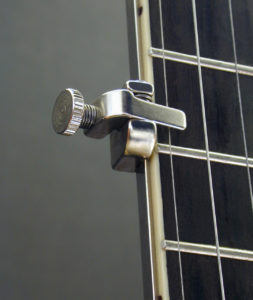5th String Capo vs. Spikes

Capoing is very common on the five string banjo. And because of the unique structure of the instrument, a regular capo does not cover the fifth string. This string requires a separate means of raising its pitch. If a banjo player ever intends to play with other musicians, then some means of raising the pitch of the fifth string must be provided. The two popular methods are:
A) A set of small model railroad spikes driven into the fretboard near the fifth string. The string is tucked under one of the spikes.
B) A 5th string capo
The spikes are the more popular choice, probably because they are viewed by some as less of an alteration to the instrument. Both methods have their pros and cons.
Arguments in favor of spikes
|
Spikes require less alteration of the instrument.
|
True. But only slightly less. Spikes make holes in your banjo, too. If you decide to uninstall the 5th string capo, the holes for the mounting screws can be filled and patched so that they’re practically invisible. |
| Spikes are less obtrusive. | Some find them more obtrusive. When I used them they would tear up my fingertips, and sometimes interfere with fretting the string. |
| Spikes look more traditional. | True. But the 5-string banjo is still evolving. Many additions have redefined its look over the years for the sake of improved functionality. |
| Spikes don’t get in the way of my thumb. | Neither does the sliding part of the capo. It is always in the same position as the 5th string peg, relative to the capo. Your thumb already knows how to work around that. Some thumb wrappers are concerned that the bar will inhibit fretting the 5th string, but most find they they quickly adapt, and that it is not an issue. |
| Earl used spikes. | You’ve got me there. But many great players use a 5th string capo. |
Arguments in favor of the 5th string capo
| Versatility. Its pressure is variable, allowing for variations in string gauge and playing attack. |
| Less tuning. Spikes pull the string sharp, requiring tuning. Also, most proponents of spikes don’t like to install them at every fret. So that means sometimes re-tuning the string an entire half-step. Not only is that a hassle, but it means that the string then can’t be fretted normally. |
| Speed. The 5th string capo tends to be a little faster — an advantage when performing. |
| Easier on the string. Using spikes a lot can cause a string to break prematurely. |
| Tone. Unless perfectly installed, spikes can sometimes buzz or mute the string. |
| Visual reference. When the capo moves up 2 frets, so does the 5th string capo, and occupies the same relative position as the 5th string peg. This can be a useful visual reference. |
Here is what Pete Wernick says in his Ask Dr. Banjo column:
“To me the Shubb is more convenient, as the capo lever slides into position and tightens right down next to the fret, without getting the string out of tune. Most arrangements with spikes pull the string out of its path, requiring additional tuning, and retuning once you are done using the spike.
” …For me, the convenience of use/accurate tuning issue trumps all the others. As a professional, I highly value anything that reduces tuning time and increases reliability.”
Even before I developed the Shubb 5th string capo, I had opted for the advantages of a capo over spikes. My own preference is obvious, but I never really take issue with players who prefer spikes. It’s a personal choice. If you’re in the process of making that choice, I hope that some of my opinions on this page are helpful.
…Rick Shubb
